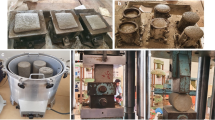Abstract
The increase in the number of thermal power plants has led to the production of an increasing amount of fly ash that causes high environmental impact in Turkey. Many researchers around the world are looking at methods of gainful utilization and disposal of fly ash. However, the construction materials industry is the most suitable way to mass consumption of the fly ash waste. In this study, the utilization potential of fly ash and silica fume in Autoclaved Aerated Concrete (AAC) production were investigated. Optimum fly ash/cement ratio was determined, and this composition was improved by the silica fume addition. Strength-Microstructure relations of the products were investigated. Crystalline C-S-H phases of Tobermorite and Xonotlite were developed after autoclaving at 4 bar. Silica fume addition was found to be useful for the prevention of the ettringite phase in the product. Silica fume addition improved the hydrothermal conditions during the autoclaving of the mixtures.
Similar content being viewed by others
References
Chan, C. F. and Mitsuda, T. (1978). “Formation of 11 A tobermorite from mixture of lime and colloidal silica with quartz.” Cement and Concrete Research, Vol. 8, No. 2, pp. 135–138.
Durack, J. M. and Weiqing, L. (1998). “The properties of foamed air cured fly ash based concrete for masonry production.” Proceedings of the Fifth Australasian Masonry Conference, Dhanasekar, M., & Lawrence, S. (Eds.), Gladstone, 1–3 July, The Queensland, Australia, pp. 129–138.
Hauser, A., Eggenberger, U., and Mumenthaler, T. (1999). “Fly ash from cellulose industry as secondary raw material in autoclaved aerated concrete.” Cement and Concrete Research, Vol. 29, No. 3, pp. 297–302.
Holt, E. and Raivio, P. (2005). “Use of gasification residues in aerated autoclaved concrete.” Cement and Concrete Research, Vol. 35, No. 4, pp. 796–802.
Huang, X., Ni, W., Cui, W., Wang, Z., and Zhu, L. (2012). “Preparation of autoclaved aerated concrete using copper tailings and blast furnace slag.” Construction and Building Materials, Vol. 27, No. 1, pp. 1–5.
Jones, M. R. and McCarthy, A. (2005). “Utilising unprocessed low-lime coal fly ash in foamed concrete.” Fuel, Vol. 84, No. 11, pp. 1398–1409.
Kearsley, E. P. and Wainwright, P. J. (2001). “The effect of high fly ash content on the compressive strength of foamed concrete.” Cement and Concrete Research, Vol. 31, No. 1, pp. 105–112.
Kurama, H., Topçu, I. B., and Karakurt, C. (2009). “Properties of the autoclaved aerated concrete produced from coal bottom ash.” Journal of Materials Processing Technology, Vol. 209, No. 2, pp. 767–773.
Pospisil, F., Jambor, J., and Belko, J. (1992). Unit weight reduction of fly ash aerated concrete, Advances in Autoclaved Aerated Concrete, Wittmann, F.H. (Ed.), A. A. Balkema, Rotterdam, pp. 43–52.
Ramamurthy, K. and Narayanan, N. (1999). “Influence of fly ash on the properties of aerated concrete.” Proceedings of the International Conference on Waste as Secondary Sources of Building Materials, New Delhi, India, pp. 276–282.
Sengupta, J. (1992). “Development and application of light weight aerated concrete blocks from fly ash.” Indian Concr. J., Vol. 66, No. 3, pp. 383–387.
Verma, C. J., Tehri, S. P., and Mohan, R. (1983). “Techno-economic feasibility study for the manufacture of lime-fly ash cellular concrete.” Indian Concr J., Vol. 57, No. 1, pp. 67–70.
Author information
Authors and Affiliations
Corresponding author
Rights and permissions
About this article
Cite this article
Serhat Baspinar, M., Demir, I., Kahraman, E. et al. Utilization potential of fly ash together with silica fume in autoclaved aerated concrete production. KSCE J Civ Eng 18, 47–52 (2014). https://doi.org/10.1007/s12205-014-0392-7
Received:
Revised:
Accepted:
Published:
Issue Date:
DOI: https://doi.org/10.1007/s12205-014-0392-7




